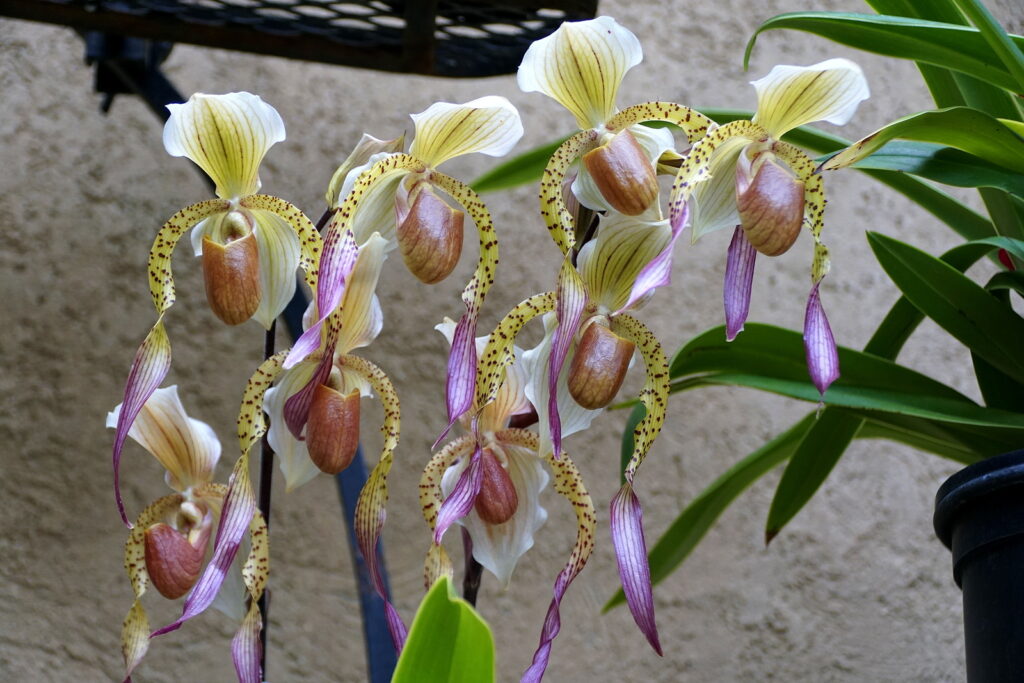Paphiopedilum is a genus of mostly terrestrial orchids that produce distinctive pouch-shaped flowers. Flowers appear in a range of colors and are often stripe or spotted.
Paphiopedilum is a genus of about 70 tropical Asian orchids commonly known as lady’s slippers or slipper orchids because of their unique pouch. Many hybrids have been developed.
Paphiopedilum have large waxy flowers of various colors and mottled or greenish leathery-textured leaves. Paphiopedilum are easily grown as houseplants; their care is very similar to African Violets.
Paphiopedilum is a genus of about 60 species of evergreen, mainly terrestrial orchids native from India to China.
Get to know Paphiopedilum
- Plant type: Mostly terrestrial orchids
- Growing zones and range: Zones 12-15
- Optimal growing temperature: For green leaves varieties: day, 60° to 75°F (16-24°C), night, 50° to 55°F(10° to 13°C); for mottled-leaved plants 70° to 80°F (21-27°C), night, 60° to 65°F (16° to 18°C) or in a cool to intermediate greenhouse.
- Height and width: 24 to 36 inches (60-90cm) tall,12 inches (30cm) wide
- Foliage: Some species have mottled leaves, some have solid green leaves.
- Flowers: Waxy blooms have a cuplike lip called a poucn. Flowers can last up to two months on the plant.
- Bloom time: Twice in a single year
- Uses: Houseplant, tropical garden
- Common name: Lady’s slipper, Venus slipper
- Botanical name: Paphiopedilum
- Family name: Orchidaceae
- Origin: Tropics and subtropics India, Southeast Asia, and the Philippines.

Where to plant Paphiopedilum
- Light: Grow Paphiopedilum indoors in bright light from southern exposure; shade only during hottest part of the day. Good circulation of fresh air.
- Plant Paphiopedilum outdoors in a moist, shady location.
- Soil: Grow Paphiopedilum in terrestrial orchid potting mix, add crushed bark and dolomitic limestone chips.
When to plant Paphiopedilum
- Set Paphiopedilum outdoors in a tropical or subtropical garden any time of the year.
Planting and spacing Paphiopedilum
- Space Paphiopedilum 12 inches (30cm) apart.
How to water and feed Paphiopedilum
- Water: Keep Paphiopedilum evenly moist; never allow growing medium to dry out completely. Humidity is best at 50%. Water Paphiopedilum moderately duirng the winter.
- Feeding: Fertilize Paphiopedilum with an all-purpose orchid food such as 20-20-20 every third watering.
Paphiopedilum care
- When blooms have finished, cut the flower spike down to the level of the leaves. Within a year, a new sike will beign to bloom.
- Repot when plant overcrowds pot space, or when growing medium has deteriorated. Best done at outset of active growth, when new roots are first visible.
Growing Paphiopedilum as a houseplant
- Grow Paphiopedilum in bright light, average to warm temperature and high humidity.
- If the light is too high, the leaves turn yellow and flowering will decrease.
- Grow in a soilless, well-drained medium to which additional sphagnum peat moss or osmunda fiber has been added, and keep it evenly moist at all times.
- Fertilize Paphiopedilum monthly.
Paphiopedilum pests and diseases
- Check Paphiopedilum for spider mites, whiteflies, mealybugs, and aphids.
- Gray moldm anthracnose, root root, iron deficiency and bacterial soft rot can occur.
Paphiopedilum propagation
- Older clumps of Paphiopedilum will separate naturally and can be repotted.
- Offsets that grow from the base of the plant can be separated and replanted when new growth begins.
Paphiopedilum varieties to grow
- Paphiopedilum belltulum. Grows 5 inches (13cm) tall; solitary, almost stemless, rounded, white or pale yellow flowers; rigid, leathery, strap-shaped leaves, mottled gree and gray.
- P. delenatii. Grows to 8 inches (20cm) tall; almost stalkless white to pink flowers; rigid, leathery, strap-shaped mottled green or gray leaves.
- P. insigne. Grows to 6 inches (15cm) tall; flowers have yellow-bronze petals and pouches and pale green-yellow to brown spotted upper sepals; lance-shape, yellowish-green leaves.
- P. Maudiae. Grows 12 inches (30cm) tall; solitary, green-and-white-striped flowers; ovate leaves, mottled light, and dark green.
- P. niveum. Grows to 6 inches (15cm) tall; solitary, powder-white flowers with small red spots; rigid, leathery, strap-shaped leaves mottled green and gray.
- P. rothschildianum. Grows to 24 inches (60cm) tall; thin purple-spotted cream petal with spotted and striped dark purple and purplish brown, yellow-rimmed pouches; semi-rigid, strap-shaped shiny, mid-green leaves.















